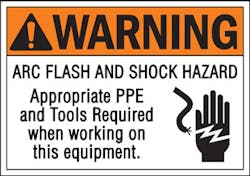The Seven Deadly Misconceptions of Arc Flash Labeling
With facilities managers being inundated with an array of regulations and requirements, it’s no wonder they’re reluctant and skeptical to embrace the NFPA 70E requirement to field-label their electrical equipment with a label containing the available incident energy or required level of personal protective equipment (PPE). This article addresses the common misconceptions regarding this requirement from the perspective of the facility owner.
OSHA (General Duty Clause and 29 CFR 1910) and the National Electrical Code (NFPA 70, Sec. 110.16) require an employer to protect both in-house and contracted workers from electric shock and arc flash. OSHA recommends and consults national consensus standard NFPA 70E, Standard for Electrical Safety in the Workplace, for compliance in this regard. Among NFPA 70E requirements, the equipment owner is required to field-label electrical equipment with a label containing the available incident energy or required level of PPE [NFPA 70E-2009, Sec. 130.3(C)]. Unfortunately, many facility owners are often reluctant to address this requirement. Following are some of the misconceptions held by facility owners that we have encountered in our practice, coupled with counterarguments to address them.
Misconception No. 1:
I haven’t received any notification or violation concerning the field-labeling of electrical equipment for arc flash hazard risk, so there is no need for me to consider your service.
Counterargument: The labeling requirement began in the 2002 version of the NEC, and the 2009 version of NFPA 70E is specific as to what information should appear on the label. In the event of an electrical accident at your facility, the absence of field-labeled electrical equipment is cause for an OSHA violation.
Misconception No. 2:
I contract out all of the electrical work at my facility; therefore, it’s not my responsibility to field-label the electrical equipment for arc flash hazard risk.
Counterargument: The labeling requirement is the responsibility of the facility owner, not the manufacturer, installer, or maintainer of the equipment, per Sec. 110.5(A) of NFPA 70E-2009. Even if contractors perform all of the electrical work, you would be held liable in the event of an electrical accident if the electrical equipment in question was not field-labeled for arc flash hazard risk.
The NFPA 70E standard requires the equipment owner to provide the information as to the required level of PPE to safeguard both in-house and contracted workers from serious injury in the event of an
electrical accident.
Misconception No. 3:
I’ve been told you are making a mountain out of a mole-hill — in that inexpensive generic warning labels can be applied to the electrical equipment to meet the requirement.
Counterargument: Generic labels, such as the one in the Figure on page 12, are non-compliant per 130.3(C) of NFPA 70E-2009, because they do not inform the in-house or contracted worker about the necessary level of PPE. Thus, in the event of worker injury due to an electrical accident at your facility, generic labels could be cited as cause for the accident.
Misconception No. 4:
The electrical equipment passed inspection when installed; therefore, I need not be concerned with applying NFPA 70E-2009-compliant arc flash hazard labels to the electrical equipment.
Counterargument: The electrical inspector certifies that the electrical equipment meets the requirements of the latest edition of the electrical code at the time of installation, not NFPA 70E-2009. In the event of an electrical accident, OSHA consults NFPA 70E in addition to the NEC for compliance with its electrical safety regulations. In the event of an electrical accident, the absence of field-labeled electrical equipment is cause for an OSHA violation — and you assume a liability risk by ignoring the arc flash hazard labeling requirement in 130.3(C) of NFPA 70E-2009.
Misconception No. 5:
I have been told the NFPA 70E-2009 arc flash hazard labeling requirement only applies to heavy-industrial facilities, and this is the reason why I need not be concerned about the requirement at my facility.
Counterargument: The NFPA 70E standard applies to a variety of facilities, according to Sec. 90.2. This includes public and private buildings and structures.
Misconception No. 6:
I have been told anyone can get the necessary information for an NFPA 70E-compliant arc flash label by simply selecting the Hazard/Risk Category number, based on the task performed by the worker, from Table 130.7(C)(9) of NFPA 70E-2009.
Counterargument: The Hazard/Risk Category number dictates the PPE. A common mistake is to simply select it based on the task performed by the worker from Table 130.7(C)(9) of NFPA 70E-2009 without understanding the limitations of the table. Section 130.7(C)(9) of NFPA 70E-2009 clearly states that the table cannot be used to select the Hazard/Risk Category if the maximum short circuit current capacity or maximum fault clearing time listed in the table footnotes is exceeded, and it is possible for either of these maxima to be exceeded in practice. In other words, one cannot simply use the table without supporting analysis of its applicability.
Misconception No. 7:
I’m off the hook if I simply address the NFPA 70E arc flash hazard labeling requirement of electrical equipment at my facility.
Counterargument: Not quite. You must ensure that other NFPA 70E requirements (e.g., electrical safety training, availability of PPE, lockout/tagout procedure, etc.) are in place for your in-house employees who are involved with the maintenance, operation, installation, and demolition of electrical equipment at the facility. In summary, compliance is not a choice. The modest investment in compliance is far less costly than the potentially tragic consequences of non-compliance.
Frank Mercede, P.E., is vice-president and Joseph Mercede is president of Mercedes Electric Co., Inc., based in Lester, Pa. They can be reached at [email protected] and [email protected].
